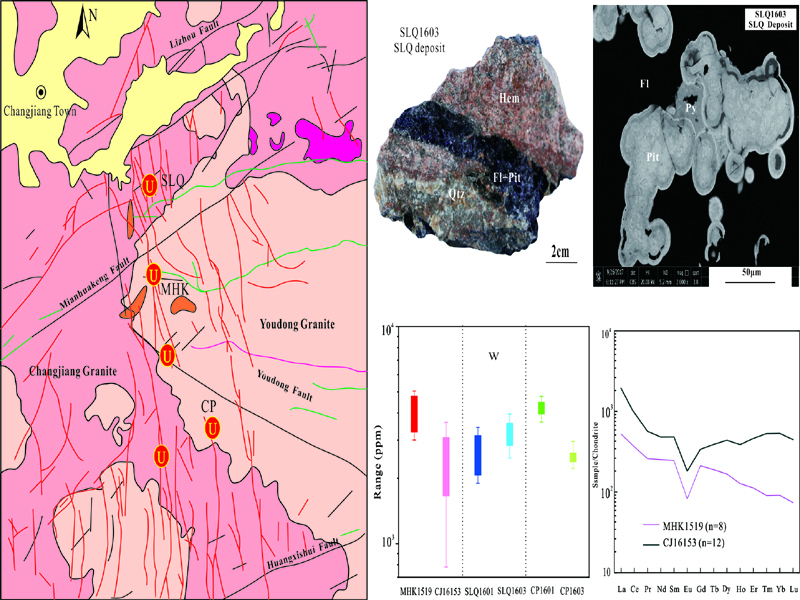
Mineralogy and geochemistry of pitchblende in the Changjiang U ore field, Guangdong Province, South China: Implications for its mineralization
ABSTRACT

The Changjiang U ore field developed typical granite-related U mineralization in the Zhuguangshan complex, China. Pitchblende is the most important ore mineral in these mineralizations. In this study, the mineralogy and geochemistry of pitchblende were investigated by electron probe microanalysis (EPMA) and laser ablation inductively coupled plasma mass spectrometry (LA–ICP–MS) to identify the genesis of the Changjiang U ore field. Pitchblende exhibits colloidal, fragmented, spherulitic and fine-grained crystals in U ores. Its geochemical compositions are similar to those of other granite-related U deposits in South China, which have elevated contents of U, Sr, As and W; low contents of Pb, Th, Zr, Nb, Ta, Hf, Co, Ni and rare earth elements (REEs); and variable amounts of Ca, Si, Bi, Y, V and Zn. These geochemical signatures suggest that mineralization occurred through hydrothermal genesis and that the hosting Youdong and Changjiang granites acted as the dominant U sources. The uraninite in these granites might be the major U source mineral. Uranium mineralization occurred under the following conditions: low temperature (<250°C), low oxygen fugacity (log fO2 = –29.5 – –25.5), weakly acidic (pH = 5.3–5.9), high CO32– and F– contents and a silicon-saturated solution. Rapid changes in the physicochemical conditions of the ore-forming fluid are responsible for the precipitation of pitchblende. Combined with previous studies, we propose that U-rich granites, Cretaceous-Tertiary crustal extensions, regional faults and hydrothermal alterations were the critical factors for U formation in the Changjiang ore field.
KEYWORDS
In-situ analysis, Pitchblende, Granite-related U deposit, Changjiang U ore field- Published : 2022
- Released on J-STAGE : 2022/06/07
- Received : 2021/08/20
- Accepted : 2022/03/31
- DOI : https://doi.org/10.2343/geochemj.GJ22006
- J-STAGE URL : https://www.jstage.jst.go.jp/article/geochemj/56/3/56_GJ22006/_article/-char/ja
- J-Online ISSN: 1880-5973
- Print ISSN : 0016-7002
- ISSN-L : 0016-7002
All Issues
- Vol.59, 2025
- Vol.58, 2024
- Vol.57, 2023
- Vol.56, 2022
- Vol.55, 2021
- Vol.54, 2020
- Vol.53, 2019
- Vol.52, 2018
- Vol.51, 2017
- Vol.50, 2016
- Vol.49, 2015
- Vol.48, 2014
- Vol.47, 2013
- Vol.46, 2012
- Vol.45, 2011
- Vol.44, 2010
- Vol.43, 2009
- Vol.42, 2008
- Vol.41, 2007
- Vol.40, 2006
- Vol.39, 2005
- Vol.38, 2004
- Vol.37, 2003
- Vol.36, 2002
- Vol.35, 2001
- Vol.34, 2000
- Vol.33, 1999
- Vol.32, 1998
- Vol.31, 1997
- Vol.30, 1996
- Vol.29, 1995
- Vol.28, 1994
- Vol.27, 1993
- Vol.26, 1992
- Vol.25, 1991
- Vol.24, 1990
- Vol.23, 1989
- Vol.22, 1988
- Vol.21, 1987
- Vol.20, 1986
- Vol.19, 1985-1986
- Vol.18, 1984
- Vol.17, 1983
- Vol.16, 1982
- Vol.15, 1981
- Vol.14, 1980
- Vol.13, 1979
- Vol.12, 1978
- Vol.11, 1977
- Vol.10, 1976
- Vol.9, 1975
- Vol.8, 1974
- Vol.7, 1973
- Vol.6, 1972-1973
- Vol.5, 1971
- Vol.4, 1970-1971
- Vol.3, 1969-1970
- Vol.2, 1968
- Vol.1, 1966-1967




